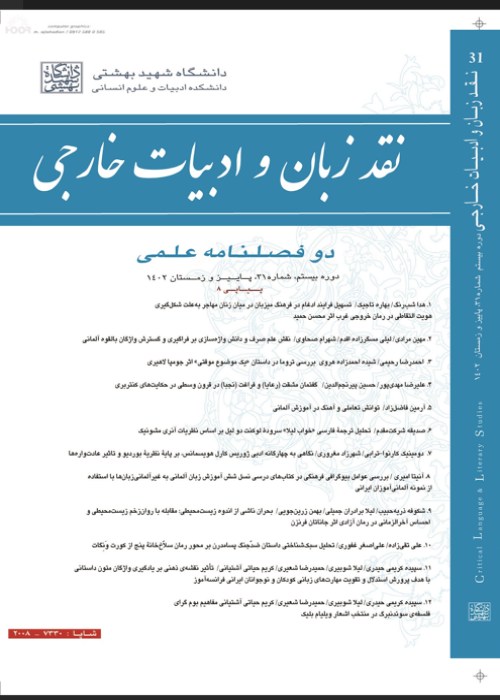A Bourdieusian Study of Food and Socio-cultural Identity in Chimamanda Ngozi Adichie’s Purple Hibiscus
Culinary literary criticism is a new field that has gathered interest among many scholars around the world. The cultural significance of gastronomic representations in literary texts is usually interconnected with the issues of gender, race, and class. The current study examines the relationship between food and socio-cultural identity in Chimamanda Ngozi Adichie’s Purple Hibiscus in terms of Pierre Bourdieu’s sociological key concepts mainly in his book, Distinction (1984). Food practices among social agents signify their habitus and the form and amount of capital available to them. In his study, Bourdieu argues that the fine basis of distinction in the tastes of individuals in different social spaces is the opposition between the tastes of luxury and the tastes of necessity. It is argued how Adichie presents the motif of food and cooking in her work to depict the social positions, the cultural identity, and the distinct tastes of the characters.
There are some books and articles about the representation of food and its cultural significance in the works of fiction written by some African writers but the number of studies carried out about English works by Nigerian writers, particularly on the selected work of the present study is considered deficient. Bishop Highfield in his book, Food and Foodways in African Narratives (2017), studies African culture and history by rendering examples of the motif of food in some works of fiction by certain African writers. In his analysis of Purple Hibiscus, Highfield studies domestic violence and resistance through the characters’ food choices. In “Dining Room and Kitchen: Food-Related Spaces and their Interfaces with the Female Body in Purple Hibiscus” (2017), Jessica Hume employs the feminine space theories derived from the British feminist, Sarah Mills’ “Gender and Colonial Space” and the Australian feminist, Grosz’s “Bodies/Cities”. Sindhu and Lydia in “Food and Social Difference in Purple Hibiscus by Chimamanda Adichie” attempt to trace the characters’ differences in their social positions through their food choices; however, there is no theoretical framework in this short article, and the writers merely present brief descriptions of the plot of the novel with some related food images. J Santhiya in “Food as a metaphor for colonial power in Chimamanda Ngozi Adichie’s Purple Hibiscus” examines the effects of colonization on the characters’ food choices but there is a lack of theoretical framework in this article too. Methodology In Distinction (1984), Bourdieu pinpoints the interrelation between his main thinking tools by arguing that practice results from the relation between one’s habitus (dispositions) and one’s capital in a specific field. Bourdieu believes that the consumption patterns of the poor and the working class are identified as “tastes of necessity,” whereas the consumption patterns of the middle and upper classes are identified as the “tastes of luxury” (Thompson and Kaplan 833). Bourdieu’s distinction between the taste of luxury and the taste of necessity is also the distinction between food as “form” and food as “function” (196). For individuals in lower economic positions in a social hierarchy, the nourishing function of food takes priority over its form (Bourdieu, Distinction 196). In contrast, individuals with more economic capital are more concerned with the food’s form, that is, food is not consumed only for the satiation of hunger but also for the fact that it gives pleasure. The present study applies Bourdieu’s notions of habitus, capital, and field to study their relations with the characters’ tastes and consumption patterns in Adichie’s Purple Hibiscus.
Pierre Bourdieu’s views on habitus and the food tastes of different classes are traceable in the study of Adichie’s Purple Hibiscus. In this novel, the characters’ related fields, and the form and amount of capital available to them are manifested in their eating practices. The religious field has a highly significant influence on Papa’s and Papa Nnukwu’s culinary practices. The consumption pattern in Papa’s household represents the taste of luxury as Papa enjoys high degrees of economic, cultural, social, and symbolic capital. On the other hand, the consumption pattern in Aunty Ifeoma and Papa Nnukwu’s homes represents the taste of necessity. Employing Bourdieu’s words, in opposition to the functional food in Aunty Ifeoma’s home, the food in Papa’s home is served with all due form. Moreover, Aunty Ifeoma’s possession of cultural capital leads her to consume nutritious food prepared at the lowest economic costs.
- حق عضویت دریافتی صرف حمایت از نشریات عضو و نگهداری، تکمیل و توسعه مگیران میشود.
- پرداخت حق اشتراک و دانلود مقالات اجازه بازنشر آن در سایر رسانههای چاپی و دیجیتال را به کاربر نمیدهد.


